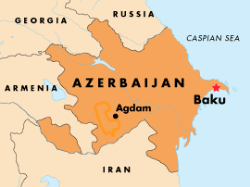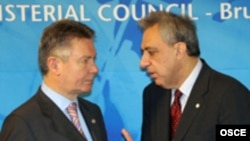The OSCE also urged the "presidents of Armenia and Azerbaijan to redouble their efforts in the coming year to finalize these basic principles as soon as possible."
The statement was less strong than earlier comments by the OSCE's chairman in office, Karel De Gucht.
"There has been some progress on the issue of frozen conflicts, particularly in Nagorno-Karabakh," De Gucht said. "The OSCE has also demonstrated proof of its usefulness recently by defusing the crisis in relations between Russian and Georgia. However, it is a fact that the situation remains largely blocked."
Talk Of Progress
The Armenian foreign minister, Vardan Oskanian, had also been upbeat. He told RFE/RL's Armenian Service that the meeting of the Armenian and Azerbaijani presidents in Minsk last week gives hope that there is a possibility to achieve agreement, even on the very difficult issues.
"Negotiations around the principles [for solving the conflict] are continuing. The approaches of the sides are getting closer on some difficult issues," Oskanian said.
Earlier, Azerbaijani Foreign Minister Elmar Mammadyarov had said that all issues were solved except for one.
That sticking point is likely to be the future status of the republic. Azerbaijan wants Karabakh to be given self-government, but within its borders.
On this point, Armenia is likely to disagree.
Speaking in Brussels, Foreign Minister Oskanian reiterated that Armenia insisted on self-determination.
"We don't see another path for solving the conflict. This is a key problem, a fundamental problem for us. As I have always said, all other issues are based on this issue," Oskanian said. "If Azerbaijan accepts the right of self-determination for Nagorno-Karabakh, then it will be possible to talk about other problems."
Bitter War
A predominantly ethnic Armenian enclave of Soviet Azerbaijan, Karabakh seceded in 1988 with Yerevan's help. Armenian forces gradually took control of the mountainous region before seizing a number of adjacent Azerbaijani administrative districts, which they continue to occupy.
The conflict claimed an estimated 35,000 lives and drove hundreds of thousands of people from their homes.
Armenia has insisted that the people of Karabakh be given the chance to vote on their future in a referendum.
"If Azerbaijan is able to have the courage to admit that the people of Nagorno-Karabakh can decide their own fate, status, and security issues, then, indeed, there are prospects to achieve serious progress in this process," Oskanian said.
But finding that "courage" could be difficult for Azerbaijan.
RFE/RL Caucasus analyst Liz Fuller says that because Karabakh's population is overwhelmingly ethnic Armenian, such a vote would almost certainly support independence.
Election Year
Over the past 12 months, the co-chairs of the OSCE Minsk Group, which is negotiating a solution to the conflict, have warned that upcoming elections in both countries could upset chances for peace.
Armenia is due to hold parliamentary elections in 2007. Both countries will hold presidential elections in 2008.
Analysts say that election campaigns will increase rhetoric and an unwillingness to compromise from both sides.
Nagorno-Karabakh
 Click on the map to see an enlarged map of the Nagorno-Karabakh conflict area.
Click on the map to see an enlarged map of the Nagorno-Karabakh conflict area.
In February 1988, the local assembly in Stepanakert, the local capital of the Azerbaijani region of NAGORNO-KARABAKH, passed a resolution calling for unification of the predominantly ethnic-Armenian region with Armenia. There were reports of violence against local Azeris, followed by attacks against Armenians in the Azerbaijani city of Sumgait. In 1991-92, Azerbaijani forces occupied most of Nagorno-Karabakh, but the Armenians counterattacked and by 1993-94 had seized almost all of the region, as well as vast areas around it. About 600,000 Azeris were displaced and as many as 25,000 people were killed before a Russian-brokered cease-fire was imposed in May 1994.
For a complete archive of RFE/RL's coverage of the Nagorno-Karabakh conflict,click here.
Of particular interest:
2005 In Review: Conflicts In Caucasus Still Characterized By Gridlock











